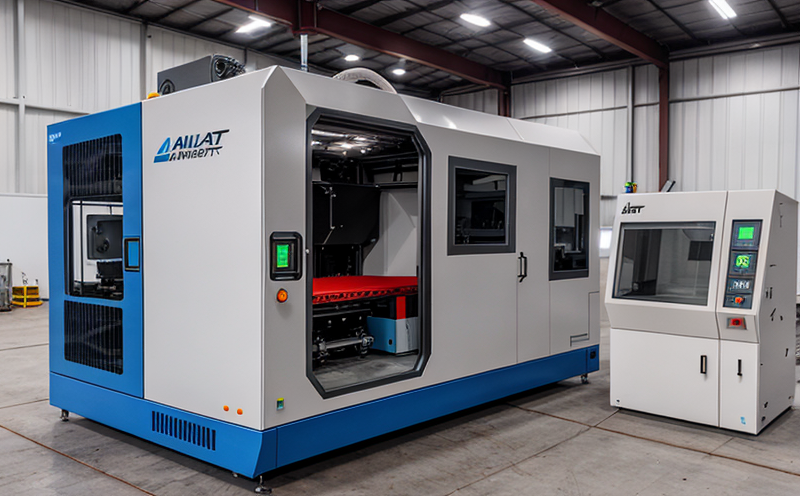ASTM F3381 NDT Testing in Additive Manufacturing
The ASTM F3381 standard provides a comprehensive framework for non-destructive testing (NDT) methods specifically designed to assess the internal integrity of parts manufactured using additive manufacturing (AM). This service ensures that AM parts meet stringent quality and safety standards, which is critical in industries such as aerospace, automotive, and medical devices. The ASTM F3381 standard addresses a wide range of NDT techniques including ultrasonic testing, radiographic examination, magnetic particle inspection, and others.
The process involves the use of advanced non-destructive methods to identify potential defects within the parts without compromising their structural integrity or functionality. This is particularly important in AM where the complexity of part geometry can make traditional manufacturing processes challenging. The ASTM F3381 standard ensures that these complex geometries are tested accurately and reliably, providing peace of mind for manufacturers.
One of the key aspects of this service is ensuring compliance with international standards such as ISO 9712:2012, which provides a framework for non-destructive testing methods. The ASTM F3381 standard builds upon these foundations to specifically cater to AM processes and materials.
The ASTM F3381 NDT service is crucial in ensuring the reliability of parts used in high-stress environments such as aerospace engines, where even microscopic defects could lead to catastrophic failures. By adhering to this standard, manufacturers can ensure that their products meet the highest quality and safety standards.
The process begins with careful selection and preparation of the sample part for testing. This involves ensuring that the part is in its final form and has undergone any necessary heat treatment or other processing steps. The part must also be cleaned thoroughly to remove any contaminants that could interfere with the NDT process.
Once prepared, the part undergoes a series of tests using various NDT methods. Ultrasonic testing (UT) is particularly effective for detecting internal flaws in AM parts due to its ability to penetrate through materials and detect defects deep within the part. Radiographic examination (RT) can also be used to visualize the internal structure of the part, providing detailed images that can help identify any imperfections.
Magnetic particle inspection (MPI) is another method that can be used for detecting surface and near-surface flaws in ferromagnetic materials. This technique involves applying a magnetic field to the part and then introducing iron particles onto its surface. Any defects will attract these particles, making them visible and easy to identify.
The results of these tests are carefully documented and reported according to ASTM F3381 guidelines. The report typically includes detailed information about the testing methods used, the results obtained, and any defects identified. This documentation is crucial for maintaining quality control and ensuring compliance with international standards.
By adhering to ASTM F3381 NDT testing protocols, manufacturers can ensure that their AM parts are of the highest quality and meet the stringent requirements set by industry standards. This not only enhances product reliability but also ensures that products are safe for use in critical applications.
Applied Standards
The ASTM F3381 standard is an essential part of the broader family of non-destructive testing standards. It builds upon existing international standards such as ISO 9712:2012, which provides a framework for NDT methods in general. ASTM F3381 specifically addresses the unique challenges posed by AM processes and materials.
The standard covers various aspects of non-destructive testing, including:
- Selection and preparation of test specimens
- Application of NDT methods (UT, RT, MPI)
- Data interpretation and reporting
The ASTM F3381 standard is recognized for its comprehensive approach to testing AM parts. It ensures that the testing process is standardized across different manufacturers and facilities, providing a level playing field for quality assessment.
International Acceptance and Recognition
The ASTM F3381 standard has gained significant recognition in the global market. Its acceptance is due to its rigorous testing protocols that ensure parts are free from defects, which is critical for high-reliability applications.
Many industries, including aerospace and automotive, have adopted this standard as a benchmark for quality assurance. The ASTM F3381 NDT service is widely used by manufacturers who need to demonstrate compliance with international standards and ensure the reliability of their products.
The standard's acceptance extends beyond just manufacturing companies; it also plays a crucial role in ensuring that parts meet regulatory requirements. For example, in the medical device industry, compliance with ASTM F3381 can be a deciding factor for market entry.
Use Cases and Application Examples
The ASTM F3381 NDT service is applicable to various sectors that rely on AM technology. Here are some specific use cases:
- Aerospace Industry: Ensuring the integrity of engine parts and structural components.
- Automotive Sector: Testing suspension systems, exhaust manifolds, and other critical components.
- Medical Devices: Verifying the safety and quality of implants and prosthetics.
In each of these sectors, the ASTM F3381 NDT service plays a vital role in ensuring that parts meet stringent quality and safety standards. The detailed testing processes help identify any potential flaws early on, allowing for corrective actions to be taken before production.





